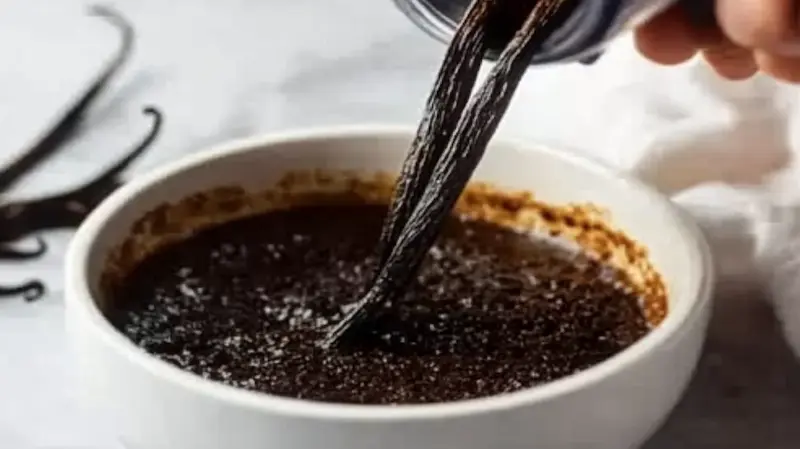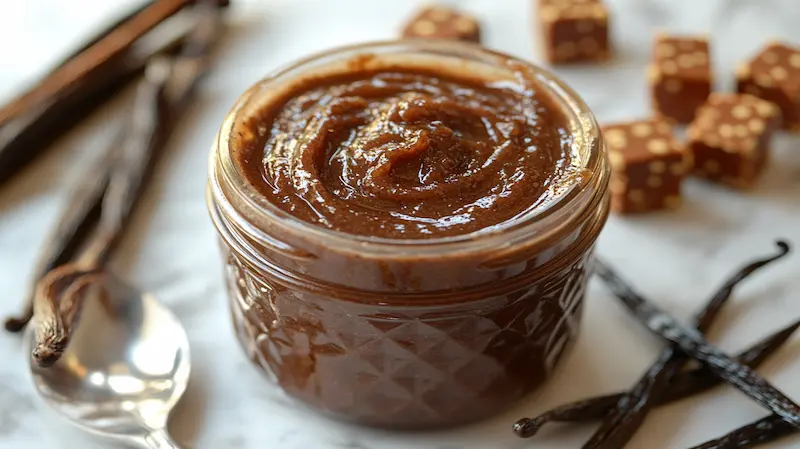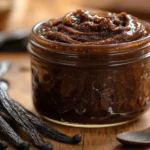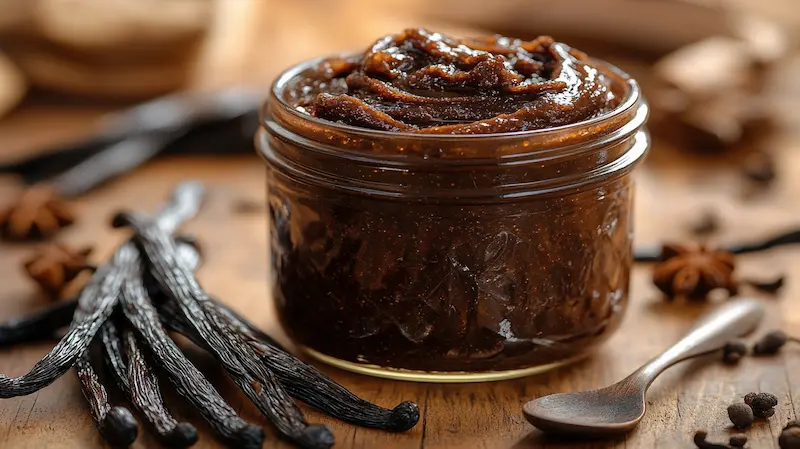Table of Contents
Vanilla bean paste recipe is a culinary gem that brings a burst of rich flavor and those signature specks of vanilla to a variety of dishes. Whether you’re a seasoned baker or just exploring the world of homemade ingredients, this guide dives deep into everything you need to know about vanilla bean paste. From understanding its unique properties to crafting your own at home, this article will walk you through the benefits, uses, and even creative recipes. Let’s get started!
Understanding Vanilla Bean Paste
What is Vanilla Bean Paste?
Vanilla bean paste is a concentrated form of vanilla that combines the aromatic richness of vanilla extract with the visual appeal of vanilla bean specks. It has a thick, syrup-like consistency, making it a go-to ingredient for recipes where both flavor and appearance matter. Unlike vanilla extract, which is purely liquid, the paste offers a blend of ground vanilla beans, vanilla extract, and sometimes sugar or thickeners.
Key Ingredients in Vanilla Bean Paste
The magic of vanilla bean paste lies in its ingredients. Typically, it contains:
- Vanilla Beans – The star ingredient, known for their complex, sweet aroma.
- Vanilla Extract – Adds depth to the flavor profile.
- Thickening Agents – Like gum arabic or xanthan gum, these provide the paste’s signature texture.
- Sweeteners – Often used to enhance and balance the natural flavor of vanilla.
How Vanilla Bean Paste Differs from Extract and Beans
When choosing between vanilla bean paste, extract, and whole beans, it’s important to understand their differences:
- Vanilla Extract: A liquid made by soaking vanilla beans in alcohol. It’s ideal for recipes where appearance isn’t critical.
- Whole Vanilla Beans: Offer the most intense flavor and are often used when you want to scrape the seeds for visual impact.
- Vanilla Bean Paste: The perfect middle ground, providing the convenience of extract with the visual appeal of seeds.
Vanilla bean paste has become a favorite for bakers because it strikes a balance between ease of use and delivering a gourmet touch.

Benefits of Using Vanilla Bean Paste Recipe
Rich Flavor and Aroma
Vanilla bean paste recipe is a powerhouse of flavor. Unlike vanilla extract, which is entirely liquid, the paste is packed with vanilla bean specks that infuse your dishes with a bold, aromatic punch. Those tiny flecks also make your desserts look extra special. Imagine a crème brûlée or custard dotted with those signature specks, it’s a simple yet stunning touch that elevates your creations.
Moreover, vanilla bean paste recipe enthusiasts swear by its ability to replicate the intense taste of whole beans without the hassle of scraping them. It’s a practical and flavorful choice for everything from ice cream to cookies.
Versatility in Culinary Applications
What’s not to love about an ingredient you can use almost anywhere? Vanilla bean paste pairs beautifully with sweet and savory dishes alike. It shines in baked goods like cakes and pastries, enhances beverages such as coffee or hot cocoa, and even adds depth to savory sauces or marinades.
Because of its thicker consistency, it stays put when mixed into batter or cream, ensuring an even distribution of flavor. If you’re looking for inspiration, check out this Vanilla Bean Paste Recipe for ideas on incorporating it into everyday dishes.
Why It’s a Better Choice Over Extract in Some Recipes
Sometimes, vanilla extract just doesn’t cut it. For recipes where you want the look and feel of real vanilla beans without spending a fortune, vanilla bean paste recipe is the perfect alternative. It provides a stronger taste than extract and eliminates the need for alcohol, making it ideal for no-bake desserts.
How to Make Vanilla Bean Paste Recipe at Home
Essential Ingredients and Tools Needed
Making your own vanilla bean paste is easier than you might think. Here’s what you’ll need:
- Vanilla Beans: Opt for high-quality, aromatic beans. Madagascar and Tahitian varieties are excellent choices.
- Vanilla Extract: For added depth of flavor.
- Sweetener: Typically, honey or sugar balances the taste.
- Thickening Agent: Gum arabic or xantham gum helps create the paste-like texture.
- Food Processor or Blender: To mix everything into a smooth consistency.
Step-by-Step Recipe
- Prepare the Vanilla Beans: Slice the beans lengthwise and scrape out the seeds.
- Blend Ingredients: In a blender, combine the vanilla seeds, sweetener, and extract. Blend until smooth.
- Add a Thickener: Gradually mix in your thickening agent until the paste reaches your desired consistency.
- Store Properly: Transfer the paste into an airtight jar and refrigerate.
Homemade vanilla bean paste can last up to six months when stored correctly.
Tips for Ensuring the Perfect Consistency
- If your paste seems too thin, add more thickening agent gradually.
- For a smoother texture, strain the mixture through a fine mesh sieve.
- Always use fresh, plump vanilla beans for the best results.
Creating your own vanilla bean paste recipe ensures freshness and allows you to control the ingredients, offering a healthier and more cost-effective option than store-bought alternatives.
Creative Ways to Use Vanilla Bean Paste
Adding Flavor to Baked Goods
Vanilla bean paste is a baker’s best friend. It adds depth to everything from cookies to cakes, with those eye-catching specks of vanilla that hint at a gourmet touch. A teaspoon of this rich paste can transform plain cupcakes into a decadent treat. Want something classic? Try incorporating it into pound cake or banana bread.
For more inspiration, check out this recipe for a Vanilla Bean Paste Cake, a must-try for dessert lovers.
Elevating Drinks and Beverages
Don’t limit vanilla bean paste to just baking! Stir it into your morning coffee for a café-style vanilla latte or add a touch to hot cocoa for an indulgent twist. Smoothies, milkshakes, and even cocktails can benefit from the smooth, aromatic flavor of vanilla bean paste.
For iced tea or lemonade, mix in a small amount of paste, it adds a subtle sweetness and complexity without overpowering the drink.
Incorporating It in Savory Dishes
Vanilla isn’t just for sweets, it works wonders in savory recipes too. Add a dash of vanilla bean paste to marinades for seafood or poultry to enhance their natural flavors. A touch in creamy sauces, like a beurre blanc, provides a unique balance of sweetness and umami.

FAQs About Vanilla Bean Paste
What Do You Do with Vanilla Bean Paste?
Vanilla bean paste is incredibly versatile. You can use it as a substitute for vanilla extract in most recipes, especially when you want the visual appeal of vanilla bean specks. It’s perfect for baking, beverages, sauces, and even savory dishes.
What Are the Ingredients in Vanilla Bean Paste?
A typical vanilla bean paste recipe contains vanilla beans, vanilla extract, a sweetener like sugar or honey, and a thickening agent such as gum arabic. Together, these ingredients create a flavorful, visually appealing paste.
How Long Does Homemade Vanilla Bean Paste Last?
When stored in an airtight container in the fridge, homemade vanilla bean paste can last for up to six months. To extend its shelf life, ensure your jar is clean and dry before use.
What is a Substitute for Vanilla Bean Paste?
If you don’t have vanilla bean paste on hand, vanilla extract or the seeds from a vanilla bean are great alternatives. However, keep in mind that neither offers the same visual appeal as the paste.
For more tips and recipes, explore our collection at Blink Recipes.
Storage and Shelf Life of Vanilla Bean Paste Recipe
Best Practices for Storage
To maintain the rich flavor and quality of your vanilla bean paste, proper storage is key. Always store it in an airtight container to prevent exposure to air, which can dry it out or reduce its potency. Glass jars with tight lids work best as they help lock in the flavor and prevent contamination.
Keep the paste in a cool, dark place, such as a pantry or a cupboard away from heat and sunlight. If you’ve made your paste at home, refrigeration is ideal. Just make sure to allow it to come to room temperature before use, as cold paste can sometimes thicken or harden.
Signs Your Paste May Have Gone Bad
Although vanilla bean paste has a long shelf life, it’s not immune to spoilage. If you notice any of the following signs, it’s time to toss it out:
- A sour or off smell, which indicates spoilage.
- Visible mold, a clear sign of contamination.
- A significant change in texture, such as extreme drying or hardening.
By following these storage tips, you can enjoy the full shelf life of your vanilla bean paste recipe, whether store-bought or homemade.
Exploring Recipes with Vanilla Bean Paste Recipe
Classic Desserts
Vanilla bean paste shines brightest in classic desserts. It’s a star ingredient in crème brûlée, where its rich flavor and those signature specks elevate the custard to gourmet status. You can also use it to transform vanilla ice cream into a decadent treat or make indulgent puddings and mousses.
For more dessert inspiration, check out this Vanilla Bean Paste Recipe for Ice Cream on Blink Recipes.
Modern, Unique Recipes
Looking to try something out of the ordinary? Incorporate vanilla bean paste into unexpected recipes like vanilla bean macarons or a twist on traditional panna cotta. It’s also an excellent addition to savory-sweet combinations, like balsamic glaze infused with vanilla for drizzling over roasted vegetables or fresh strawberries.
Experimenting with vanilla bean paste can inspire you to explore bold flavors and create dishes that surprise and delight your taste buds.
Buying Guide: Choosing the Best Vanilla Bean Paste Recipe
How to Read Labels for Quality
When shopping for vanilla bean paste, it’s important to know what to look for. Start by checking the ingredients list. High-quality options will include real vanilla beans, vanilla extract, and a natural thickener. Avoid products with artificial flavors or high amounts of added sugar, as they can dilute the authentic vanilla experience.
Another indicator of quality is the origin of the beans. Look for varieties made from Madagascar, Tahitian, or Mexican vanilla beans, as these are renowned for their unique and rich flavors.
Popular Brands and Options
The market is filled with great choices for vanilla bean paste recipes. Some well-known brands include Nielsen-Massey, Heilala, and Taylor & Colledge. These brands are trusted by professionals and home bakers alike for their consistency and superior taste.
If you’re on a budget, some generic options also deliver excellent flavor. Just be sure to read reviews and compare ingredients to find the best value for your money. Investing in a high-quality paste ensures your dishes have that authentic vanilla taste every time.
Conclusion: The Magic of Vanilla Bean Paste Recipe
Vanilla bean paste is more than just an ingredient; it’s a game-changer in the kitchen. Its combination of rich flavor, visual appeal, and versatility makes it a must-have for anyone who loves to cook or bake. Whether you’re making classic desserts, experimenting with modern recipes, or crafting your own vanilla bean paste recipe at home, this magical ingredient elevates everything it touches.
From understanding its unique properties to learning how to make and store it properly, you’re now equipped to get the most out of vanilla bean paste. So go ahead, explore new recipes, and let this versatile ingredient bring a gourmet touch to your culinary creations.
For even more tips and inspiration, don’t forget to explore Blink Recipes and discover a world of delicious possibilities!

Vanilla Bean Paste
Ingredients
Main Ingredients
- 5 beans Vanilla Beans Opt for high-quality Madagascar or Tahitian varieties.
- 1 cup Vanilla Extract For added depth of flavor.
- 1 cup Sweetener (Honey or Sugar) Balancing the taste.
- 1 teaspoon Thickening Agent (Gum Arabic or Xanthan Gum) Helps create the paste-like texture.
Instructions
Preparation
- Slice the vanilla beans lengthwise and scrape out the seeds.
- In a blender, combine the vanilla seeds, sweetener, and vanilla extract. Blend until smooth.
- Gradually mix in your thickening agent until the paste reaches your desired consistency.
- Transfer the paste into an airtight jar and refrigerate.

